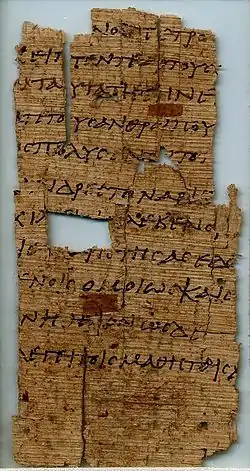Papyrus 28
Papyrus 28 (nach Gregory-Aland mit Sigel 28 bezeichnet) ist eine frühe griechische Abschrift des Neuen Testaments. Dieses Papyrusmanuskript des Johannesevangeliums enthält nur die Verse 6,8–12 und 17–22. Mittels Paläographie wurde es auf das späte 3. Jahrhundert datiert.[1]
| Papyrus 28 | |
|---|---|
 | |
| Johannes 6,8–12 | |
| Name | P. Oxy. XIII 1596 |
| Text | Johannes 6 † |
| Sprache | griechisch |
| Datum | 3. Jahrhundert |
| Gefunden | Oxyrhynchus, Ägypten |
| Lagerort | Pacific School of Religion |
| Quelle | B. P. Grenfell & A. S. Hunt, Oxyrynchus Papyri XIII, (London 1919), S. 8–10 |
| Größe | 10 cm × 5 cm |
| Typ | Alexandrinischer Texttyp |
| Kategorie | I |
| Hand | halbunzial |
| Notiz | nahe an א |
Beschreibung
Der Papyrus wurde in mittelgroßen Halbunzialen geschrieben.[2] Es handelt sich um ein einzelnes Blatt, das mit 12 Zeilen pro Seite beschrieben ist. Es werden Nomina sacra verwendet, jedoch unvollständig.
Text
Der griechische Text des Kodex repräsentiert den Alexandrinischen Texttyp (oder eher einen proto-Alexandrinischen Texttyp). Kurt Aland ordnete ihn in Kategorie I ein.[3] Die Handschrift zeigt größte Übereinstimmung mit 75 (in 7 von 10 Varianten).[1] Gemäß Grenfell und Hunt ist es näher am Sinaiticus als am Vaticanus. Nur in einem Fall stützt es den Codex Alexandrinus gegen Sinaiticus und Vaticanus (Johannes 6,11).[2] Grenfell und Hunt merkten an, dass der Text „nicht sehr korrekt gesprochen“ ist. Er besitzt fünf einzigartige Lesarten. In Johannes 6,10 heißt es πεντακισ]χιλειοι, ελεβεν anstelle von ελαβεν, in 6,19 ενγυς anstatt εγγυς, in 6,20 φοβεισθαι anstelle von φοβεισθε, in 6,22 ιδεν statt ειδεν.[4]
Geschichte
Das Manuskript wurde zusammen mit anderen Dokumenten des 3. und 4. Jahrhunderts in Oxyrhynchus gefunden.[2]
Es wurde in der Pacific School of Religion (Pap. 2) in Berkeley aufbewahrt[5] und 2015 an einen privaten Sammler verkauft.[6]
Siehe auch
Literatur
- Kurt Aland: Kurzgefaßte Liste der griechischen Handschriften des Neuen Testaments – in Verbindung mit Michael Welte bearb. von Kurt Aland. 2. neubearbeitete und ergänzte Auflage. de Gruyter, Berlin / New York 1994, ISBN 3-11-011986-2 (Arbeiten zur neutestamentlichen Textforschung, Band 1).
- B. P. Grenfell, A. S. Hunt, Oxyrynchus Papyri OP XIII. London 1919, S. 8–10, Textarchiv – Internet Archive.
Weblinks
- Robert B. Waltz. NT Manuscripts: Papyri, 28.
Anmerkungen
- Philip W. Comfort, David P. Barrett: The Text of the Earliest New Testament Greek Manuscripts. Tyndale House Publishers Incorporated, Wheaton IL 2001, S. 122.
- B. P. Grenfell, A. S. Hunt: Oxyrynchus Papyri XIII. London 1919, S. 8.
- Kurt und Barbara Aland: Der Text des Neuen Testaments. Einführung in die wissenschaftlichen Ausgaben sowie in Theorie und Praxis der modernen Textkritik. Deutsche Bibelgesellschaft, Stuttgart 1989, ISBN 3-438-06011-6, S. 107.
- Peter M. Head: The Habits of New Testament Copyists Singular Readings in the Early Fragmentary Papyri of John. Biblica 85 (2004), S. 406.
- Kurt Aland, Barbara Aland: The Text of the New Testament: An Introduction to the Critical Editions and to the Theory and Practice of Modern Textual Criticism, transl. Erroll F. Rhodes. William B. Eerdmans Publishing Company, Grand Rapids MI 1995, S. 97.
- Another Oxyrhynchus papyrus from the Egypt Exploration Fund distributions sold to a private collector, abgerufen am 9. September 2016